1960s
Anti-Communism and Chinese-American Restaurants of the 1960s
By: Madison Bencini, Somi Benrashid,
and PJ Helderlein
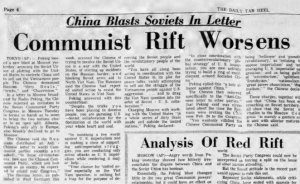
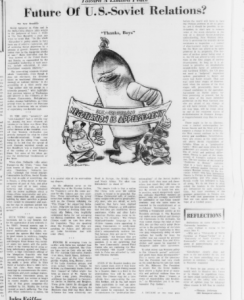
Anti-Communist sentiments ran high in the United States during much of the 1960s. China’s participation in a Communist leadership style drove much of the Red Scare and McCarthyism, thus continuing a pattern of discrimination against Chinese-Americans and their businesses well into the 1960s. America’s refusal to recognize the new this form of leadership largely translated into a lack of representation of Chinese restaurants in American media, as seen in the scarcity of Chinese restaurant advertisements.
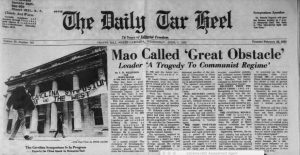
This article details the distaste for Mao Zedong from the UNC student population and his ineffectiveness at the end of the 1960s. It’s presence as a front page piece shows how important Anti-Communist strife was to the liberal arts campus of UNC.
Chinese Influence on American Cuisine
Piedmont Aspect
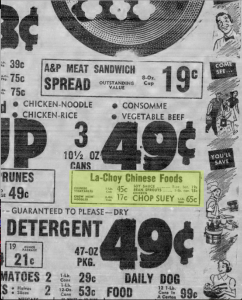

However, we were able to uncover some small nuances of its relevance in American food culture of the time. Here in this grocery ad for an A&P grocery store, La-Choy Chinese foods are advertised, featuring familiar dishes such as chop suey.
Coastal Aspect
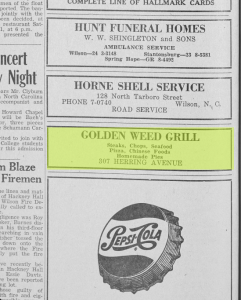

An advertisement for the Golden Weed Restaurant in Wilson, NC is shown here. By observing the image we can see the restaurant offers steaks, chops, and seafood in addition to Chinese food. This is likely an attempt to appease the taste pallets of American consumers in order to bring in a wider variety of clients to the restaurant. Additionally, the ads were published 8 years apart from one another. It’s interesting to see that the restaurant continued serving both American and Chinese cuisines throughout this time period.
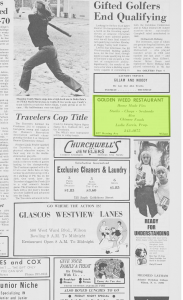
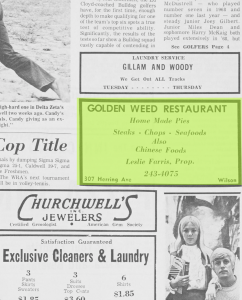
Mountain Aspect
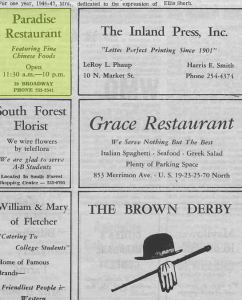
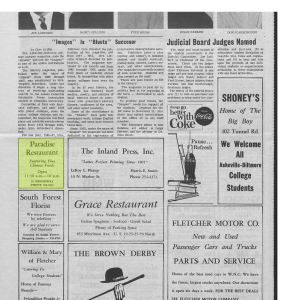
The Paradise Restaurant in Asheville, NC sent out advertisements in the local newspaper named The Ridgerunner. The phrasing used in the ad is similar to those in the surrounding advertisements, signifying an attempt to resemble other establishments considered fine-dining (such as the Grace Italian restaurant in the same image).
United States – Chinese Relations

During the 1960s, the relationship between the United States and China was fairly unstable. Prior to World War II, the United States had a fairly good relationship with the Republic of China (ROC). However, in the aftermath of the war, the People’s Republic of China (PRC) took over mainland China while the ROC remained in control of Taiwan. The United States was comfortable with their relationship with the ROC, but also strongly anti-communist. The PRC was openly communist causing a rift between the two countries. During the 1960’s, the United States recognized the ROC as the governing power of China localized in Taiwan. Pictured to the left, Dwight D. Eisenhower projected these values by visiting the President of Taiwan in support of the ROC.
Chinese Women of the 1960s

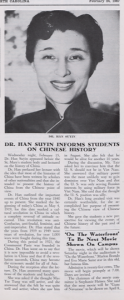
While hard to make out, the article on the left detailed the job and life of a Duke Hospital cafeteria worker. The woman pictured, Shen-Fan-Sung, was a lieutenant colonel in the Chinese Nationalist Army in Taiwan before moving to Durham to become a certified Dietician. She planned to use her time working in the hospital in order to better prepare for duty at National Defense Medical Center in Taiwan.
On the right, this article recounted the experience of hearing Dr. Han Suyin, an intellectual on Chinese history, speak at the St. Mary’s School for Girls. Her lecture on the history of China and current stance on the war against Communism in the United States provided an interesting perspective of the animosity between these world powers.
While not related in their professions, these women highlight the views of Chinese culture and the immigrant experience in American society. While Communist China was isolated and stigmatized by the American public at this time, the ability of these women to persevere to become leaders in their individual fields was remarkable. Their experiences can be related to that of the Chinese restaurant owner and worker experience at this time, as they too were affected by the social perceptions of Chinese political actions of the 1960s.
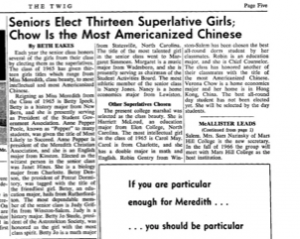
While not related to the Chinese restaurant culture of the time, this article exemplifies the true feelings towards the individuality of the Chinese population. The creation of a superlative titled “The Most Americanized Chinese” served the purpose of framing the need for the American public to avert from accepting the Chinese culture as unique. The push towards assimilation is seen in the lack of representation of Chinese-American restaurants in the media.
Research Methodology:
In order to conduct research concerning Chinese restaurants located in North Carolina during the 1960s, our journey began at the North Carolina Special Collections section of Wilson Library at UNC Chapel Hill. By searching in a restricted time period, using common keywords for restaurant names such as “China” or “Golden”, we were able to locate resources in the collection we could request to view. Ultimately the majority of our success in the Special Collections came from looking at city directories under the restaurant heading. By locating restaurant titles in different urban areas we were able to refine the next phase of our research.
This second phase utilized the search function of the DigitalNC website (http://www.digitalnc.org/). Searching the names of restaurants found in the city directories allowed us to pinpoint newspaper articles containing ads for those restaurants. The search was additionally modified to produce results within the years 1960-1969. All images above were procured by the source, DigitalNC, except the photo regarding President Dwight D. Eisenhower. This image is referenced below.
Source:
https://www.alamy.com/stock-photo-president-dwight-d-eisenhower-1890-1969-stands-next-to-president-chiang-135049383.html